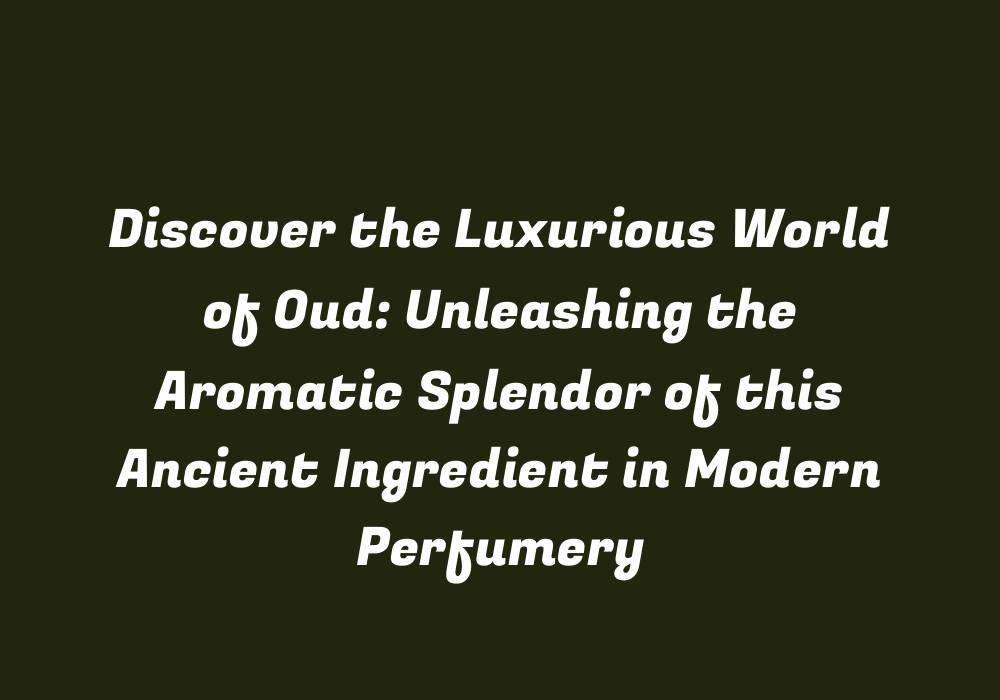Introduction: Oud – The Mysterious Fragrance with an Ancient History
Oud, also known as agarwood, has been a revered and cherished ingredient in the world of perfumery for centuries. It is an aromatic resinous wood that originates from trees belonging to the Aquilaria family. This precious material has been used in various cultures around the globe for its enthralling fragrance and captivating historical significance. In this article, we will explore the enchanting world of oud and dive deeper into its fascinating journey throughout history to understand its role in modern perfumery.
The Origins of Oud: A Timeless Fragrance
Oud has been a part of numerous cultural and religious rituals for centuries, dating back as far as the ancient Egyptians and Chinese. It is believed that its use in perfumery emerged around 500 BCE in Southeast Asia, particularly in Myanmar and Thailand. The scent was highly regarded by royalty, and it became a symbol of wealth and prestige within society.
In the Middle East, oud gained further prominence as an essential component of perfumes and incense during the Islamic Golden Age (8th to 14th centuries). It was often used in religious ceremonies, such as in the holy Muslim tradition of Eid al-Fitr, where oud is burned to symbolize forgiveness. The captivating aroma has since been deeply integrated into Arabic and Middle Eastern culture, making it an essential part of their perfumery heritage.
The Unique Process of Oud Production
Agarwood trees grow in tropical climates where they are susceptible to fungal infection that causes the tree to produce a resinous substance known as agarwood. This valuable resource is highly sought after due to its rich and complex scent profile. The production process of oud involves drying, aging, and carefully crafting the raw material into various forms such as chips, essential oil, or absolute for use in perfumes.
Oud’s rarity and high value make it an exclusive commodity that has often led to illegal practices such as deforestation and poaching of protected species. This problem has spurred conservation efforts and research initiatives to cultivate agarwood trees through sustainable methods while maintaining the quality and authenticity of the material.
The Aromatic Profile of Oud: A Unique Blend
Oud offers a distinctive, exotic scent that is often described as woody, smoky, and slightly sweet. It possesses an enigmatic blend of various aroma molecules that create an alluring fragrance profile. The heart notes are characterized by their unique combination of ambery and leathery accents, while the base notes exude a deep, earthy and musky sensation.
Its complex nature has made oud a popular choice for perfumers seeking to create intriguing fragrances that evoke an air of luxury and sophistication. As a result, it is frequently incorporated into high-end perfumes catering to discerning customers who appreciate the finer things in life.
Oud in Modern Perfumery: A Timeless Ingredient with Contemporary Appeal
In recent years, there has been a resurgence of interest in oud-based fragrances as consumers increasingly look for unique and distinct perfume experiences. Brands such as Tom Ford and Byredo have incorporated agarwood into their lines to cater to this growing demand. These luxury brands often pair oud with other rich and evocative ingredients, creating a captivating blend that reflects the essence of modern perfumery.
The use of synthetic molecules in fragrance compositions has also led to advancements in oud-based scents, allowing for more precise control over aroma profiles while maintaining the integrity of the natural raw material. This approach has opened new possibilities for experimenting with unique combinations and creating innovative fragrances that push the boundaries of perfumery.
Conclusion: The Enduring Allure of Oud in Perfumery
Oud remains an essential component in modern perfumery, captivating audiences with its timeless appeal and unparalleled aromatic complexity. Its history, production process, and unique scent profile have made it an irreplaceable element within the world of luxury perfumes. As consumers continue to seek out new experiences and rare ingredients, oud will undoubtedly remain a treasured part of this evolving industry.
In its journey through time, oud has remained a symbol of wealth, power, and cultural significance. Its enduring allure in the fragrance world reflects the essence of this remarkable ancient ingredient – a testament to the beauty and mystery that continues to captivate our senses even today.
